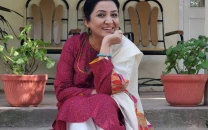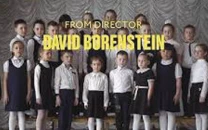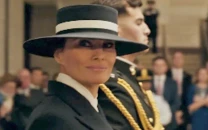Art exhibition: Nine lives at Khaas Gallery
The paintings displayed in the art exhibition seek to create dialogue.

Art exhibition: Nine lives at Khaas Gallery
An exhibition of fresh works by Indus Valley School of Art 2010 graduates (Aazia Alam, Ailya Moosavee, Cyra Ali, Mariam Maqsood, Samina Halai, Sammer Sultan, Shayaan Meer, Tuba Zaki and Zain Ashir) opened at Khaas Art Gallery on Wednesday. The collection, ‘Nine Lives 2012’, was a mixed bag: a variety of mediums and conceptual approaches, hence, the lack of cohesion creates an overwhelming effect, as if too much were being accomplished in one exhibition.
However, what the collection lacks in focus, it makes up for in creativity and diversity. Take Ailya Moosavee’s three untitled charcoal-on paper entries, for instance: thematically the strongest, Moosave’s dark aesthetic delves into disturbed, internal spaces. “Spaces of the familiar and the unknown make me question my identity,” explains the artist. “It’s an identity that finds residence in this land of the unknown,” she adds. Moosavee underscores this sense of ‘unknowing’ through her use of shadows, dark textures and darker subject matter, creating a feeling of both enigma and horror.
On a different wavelength altogether, Cyra Ali’s work alludes to a veiled eroticism that is arresting and surprising. She combines all the erotic aspects of the ‘body’ with flowers as seen in ‘bouquet’ — needlepoint on fabric. What looks like a floral pattern from a distance, becomes a sequence of tiny legs upon closer inspection, hinting at a veiled or disguised form of femininity. “Many conventions of femininity and tradition are based on patriarchy’s desire to ‘tame’ women and repress their sexuality. My work engages in questioning such notions,” says Ali. Similarly, her work also attempts to make the viewer question his/her perspectives. This is evident in her fabric, polyester and wire sculptures, scandalously arranged in suggestive configurations in an alarming and powerful challenge to the patriarchal gaze.
Meanwhile, Shayaan Meer’s single, untitled entry (oil on canvas) is possibly the most visually arresting (immediately at least) from its peers. We have the scale of the canvas to thank for that: a colossal portrait depicting a reclining woman in shalwar kameez staring a little brazenly out of the frame with a cigarette in hand. Behind her, orange flames sprout out, rendered in a basic, crude style. Viewers are immediately reminded of corny Lollywood or truck art, which is fine when one places the work within a conceptual framework. But this becomes increasingly difficult when the artist provides no such context. The subject matter remains mysterious as the artist refrained from submitting any information about her work or herself; is this an attempt to leave the work open to viewer introspection and interpretation? What is the subject’s story? What has this femme fatalle done; and to what effect? We are left to conclude that, when it comes technical skill, the work comes off amateurish when juxtaposed with the other eight Indus Valley artists.
At the same time, the mysterious nature of Meer’s work is strength unto itself: good art should be able to instinctively grasp its beholder’s attention; it should create dialogue, push questions. This dialogical engagement is a crucial hallmark of the collection: each artist, in his or her own way, is making queries and seeking answers for the big, elusive questions of religion, life, death, sexuality and gender.
Published in The Express Tribune, January 13th, 2012.



















COMMENTS
Comments are moderated and generally will be posted if they are on-topic and not abusive.
For more information, please see our Comments FAQ